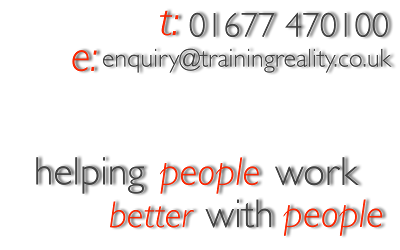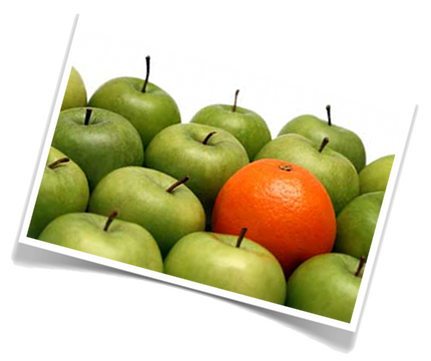Please press (at least!) one of these.
It costs you nothing, and (possibly) helps us spread the word!
They're not the same as us
Tuesday, 22 May 2012
As a wide-ranging training and development consultancy, we're in a very fortunate, and rewarding, position of being able to draw experiences from a very wide range of industries - wider even than the ones we've worked for directly ourselves. Making those connections, seeing parallels between organisations and problems, is one of the many things we thrive on. But it's not without its challenges.
One of the many challenges we get, for example when training decision making or commercial creativity, is from delegates who say but it's different for us; we're not like XXX. And, of course, they're absolutely right. And absolutely wrong as well.
The crux of the issue is that it is perfectly possible for two people to look at a pair of "things", and for one to instinctively focus on the differences, whereas the other may instinctively focus on the similarities. When training business teams, the balance tends towards the former; for very good reasons, most organisations want to see themselves as different, or even unique.
This was highlighted recently, in a week where we'd worked with one of the world's biggest retailers at the start of the week, and a local not-for-profit organisation providing a service to the public sector. We work with both on creativity and decision making, and it's fascinating, frustrating and fantastic to observe and experience the differences - as well as the similarities - as a (relatively!) neutral outsider.
At a very superficial level (which is always a challenge to dig behind!), the retailer is all about standardising, simplifying, and streamlining. The not-for-profit is all about variation, localism, and flexibility. One provides a service to millions of people across the globe; the other provides one to an area roughly 15 miles in diameter. One wants to attract as many people from as wide a range as possible; the other has a very specific, tightly-targeted and narrow demographic. What could they possibly learn from one another?
Like (most/all?) stereotypes, there is a reasonably firm foundation to these beliefs, which is why they can be tough to overcome. The way we approach this is to push groups to "scrape the bottom of the barrel" in coming up with possibilities (this is one of my personal favourite metaphors - the bottom of the barrel is where some of the richest "stuff" is found!). In this case:
- Both want to provide the best service at the lowest possible cost
- Both have "customers" with unpredictable, changing and varying demands
- Both operate in highly competitive environments
- Both have a need/desire to maximise revenue
- Neither can afford to continue doing the same things forever
- Neither has all the right answers within their own organisation
- Neither knows what the future is going to look like
- Both are staffed by, and provide services to, people.
We would argue that the list of similarities is longer and stronger than the list of differences (if such metrics were able to be calculated meaningfully). What is really different is the approach taken. To refer back to an earlier blog that explored Simon Sinek's Golden Circle theory (click here), there is plenty of common ground in the How and Why areas; the biggest differences are in the What field. As that is the case, it is actually far easier to learn from groups or organisations who appear profoundly different than it may seem at first.
We leave you with the challenge we often give to our training clients: as soon as you start seeing differences, switch your mindset to looking for similarities. And don't forget to scrape the bottom of the barrel for all the submerged richness!
Please press (at least!) one of these.
It costs you nothing, and (possibly) helps us spread the word!



